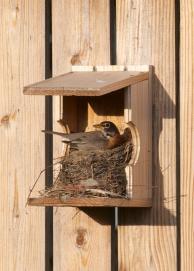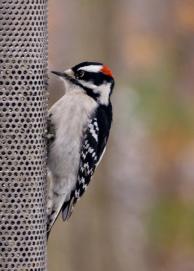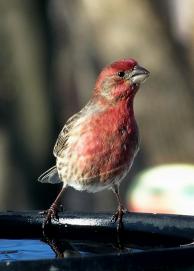House Finch (Male)

For folks just getting into the bird thing, one of the first confusing dilemmas they are faced with is: Is that a House Finch or a Purple Finch at my feeder? Don’t feel bad, they are closely related cousins and the differences aren’t always cut and dry. Hopefully this will help.
First and foremost, let the time of year help you with your identification. Purple finches are only here in the winter (and definitely not every winter). If you have one of these birds at your feeder from May through September, you can be pretty confident that it is a House Finch.
From October through May you will need take a little closer look. As you might well imagine, if you have both of them at your feeders at the same time, the ID is much easier.
Your first instinct is likely to try and make your ID on color. After all, aren’t Purple Finches purple? Isn’t there a rental car ad campaign that was based on the phrase “not exactly”? The way I like to describe it is: male House Finches are a Cardinal red with light brown streaking while the Purple Finch looks like it has been held by the feet and dunked in raspberry cool aid. To me, a Purple Finch has an all over wash to it while the red on a House Finch tends to be confined to certain parts of the head, chest and rump.
Field guides will tell you to look for a notched tail. This varies greatly with the wind and posture of the individual bird. Another famous field mark, the brown streaking on the lower sides of the belly on the House Finch can be confusing as well because Purple Finches will have the appearance of streaking at times (though usually not brown).
The very best, and in my opinion the easiest, way to tell them apart is to be patient and look for the females. The females do not have the red/raspberry color and they look very different. The female Purple Finches are much darker than the House Finch females and they have a bold wide eye stripe that runs through the eye and down the side of the neck. Female House Finches are the plainest of the plain. Light grey with light brown streaking.
Here is another good clue. You know that bold eye stripe the female has? The male has it as well but it is washed out with the raspberry color. Binoculars will help you see this field mark on the males.
For close cousins, they sure lived at opposite ends of the continent. The House Finch (Carpodacus mexicanus) was once known as the Hollywood Finch for its beautiful song. As the name mexicanus indicates, it is native to the dry desert southwest country and has only arrived in our area in the last 10 years or so.
Purple Finches (Carpodacus purpureus) are the state bird of New Hampshire which is a pretty good indication of where they prefer to live. Nesting in the coniferous forest of the north woods, they invade our area sporadically (generally associated with poor pine seed production up north).
The Carpodicus finches are a great pair of birds and can easily be attracted to your feeders with sunflower, safflower or finch mixes.
** House and Purple Finches have been changed to the genus Haemorphous by the American Ornithological Union a few years after this article was written.
Mark's Spotlight
-

American Gold Finch
Read more about the American Goldfinch -

American Robin
Read more about the American Robin -

Black-Capped Chickadee
Read more about the Black-Capped Chickadee -

Downy Woodpecker
Read more about the Downy Woodpecker -

House Finch (Male)
Read more about House Finch -

Northern Cardinal
Read More about Northern Cardinal
Shop Now!
-
Mark's No-Waste Blend™
Regular price From $15.99 USDRegular price -
Boardwalk Blend™
Regular price From $8.99 USDRegular price -
NP1009 OrioleFest
Regular price $29.99 USDRegular price -
Multi-Seed Tube Feeders w/Quick-Clean® Bases
Regular price From $59.99 USDRegular price











